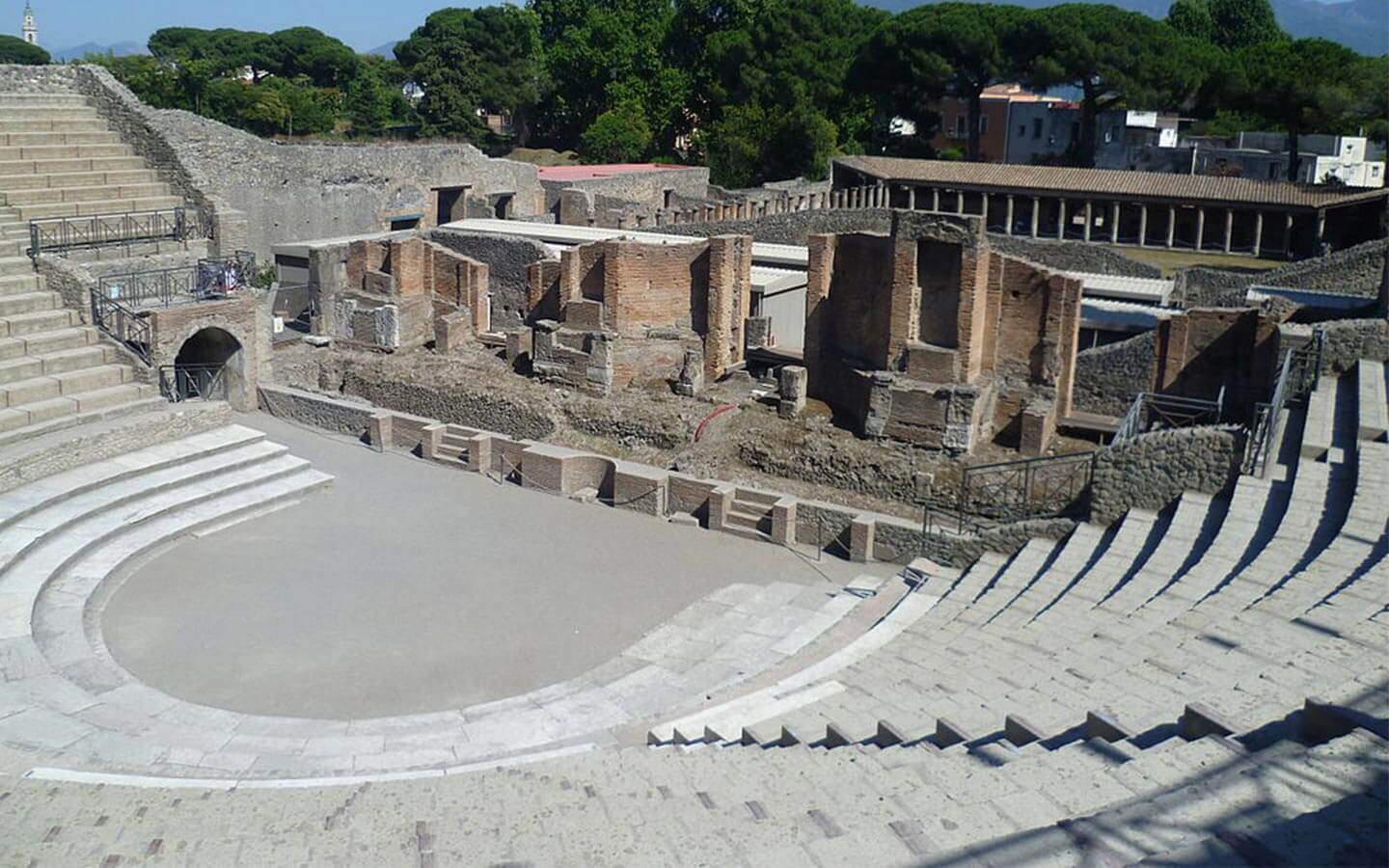Pompeii – history entices, drawing you into its splendid history, unfolding the narrative of its dramatic downfall, revealing the mesmerizing archaeological treasures, and showcasing its lasting impact on today’s culture, film, and digital landscapes.
Geographical Context of Pompeii
Pompeii, an ancient city of the Roman Empire, was situated at the base of Italy’s Mount Vesuvius, near the Bay of Naples. This location played a dual role in its destiny.
Its position in the fertile Campanian plain supported a rich agricultural industry, and its proximity to the Bay of Naples made it a bustling port city. These geographical advantages allowed Pompeii to flourish as a hub of trade and cultural interchange.
However, these benefits came with a perilous cost. The city lay in the ominous shadow of Mount Vesuvius. The volcano, long dormant, unexpectedly erupted, leading to one of history’s most devastating natural disasters. This tragic event forever marked Pompeii as a symbol of nature’s powerful, unpredictable forces.
History of Ancient Pompeii Before the Eruption
Pompeii, originally an Oscan settlement in the 8th century BC, grew into an integral city of the Roman Empire by the 6th century BC, when it came under Roman influence. Its strategic location near the Bay of Naples positioned it as a key hub for commerce, its fertile plains produced bountiful crops, and its fishing industry thrived due to its proximity to the sea.
The city was designed in a typical Roman grid system, with houses, shops, and public buildings lined along the paved streets. The Forum, the heart of any Roman city, was a sprawling space in Pompeii surrounded by various public buildings, temples, and markets. It was a venue for political gatherings, religious rituals, and economic transactions. Pompeii was also home to a sophisticated amphitheater that could accommodate about 20,000 spectators, indicative of its cultural prominence.
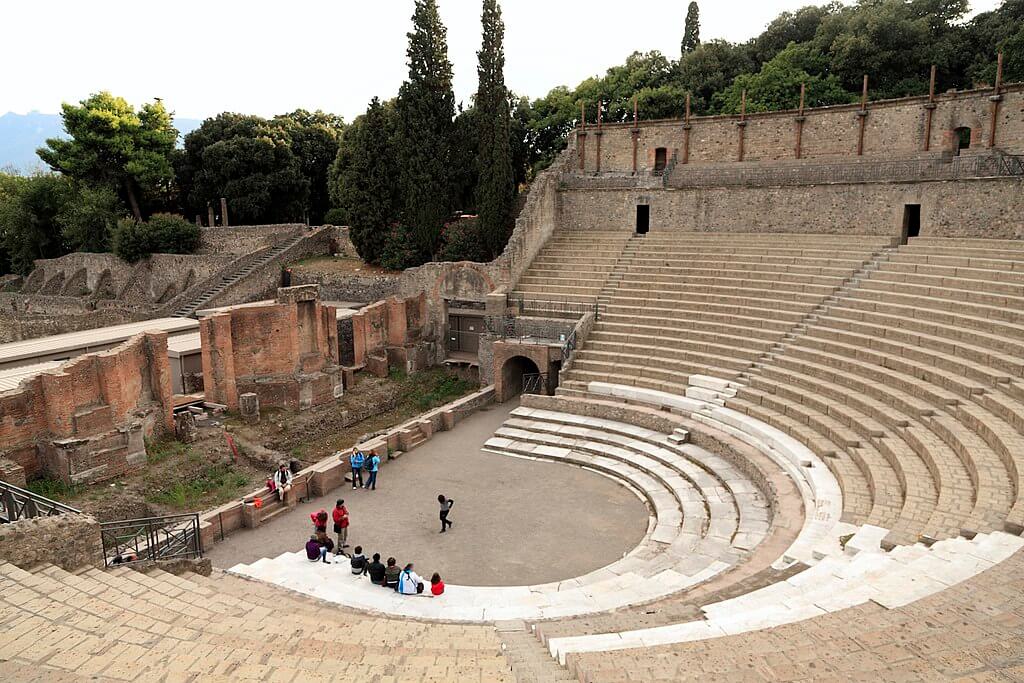
Pompeii was a bustling city teeming with diverse social classes. It was home to the patricians – the wealthy and politically powerful – who lived in elaborate domus (houses) complete with gardens and water supply. The equestrians (business class) and plebeians (common people) formed the majority of the population and lived in more modest dwellings.
However, Pompeii was not without its challenges. It experienced social unrest, political changes, and infrastructure damage from natural disasters. In 62 AD, a severe earthquake rocked the city, causing significant structural damage. Despite the disaster, the resilient Pompeiians embarked on a widespread reconstruction project, indicating the city’s economic strength and the inhabitants’ determination.
Despite the hardships, Pompeii was a city brimming with life and cultural diversity. From intricate frescoes and graffiti on the walls to the remains of the amphitheater and temples, every artifact tells a story of a thriving society that valued art, commerce, religion, and public discourse. The vibrant social, cultural, and economic life of Pompeii would continue until that fateful day in 79 AD, when Mount Vesuvius dramatically reshaped the city’s destiny.
The Catastrophe – Mount Vesuvius Eruption
On August 24, 79 AD, Mount Vesuvius, a stratovolcano overlooking the vibrant city of Pompeii, unleashed a catastrophic eruption. This natural disaster drastically altered the course of Pompeian history, transforming the bustling city into a silent tableau frozen in time.
Before the eruption, Vesuvius had been inactive for centuries, with its benign appearance offering no hint of the latent danger it posed. On the day of the disaster, a massive plinian eruption occurred, spewing a column of ash and pumice twenty miles into the sky. The city, lying a mere six miles from the volcano, was subjected to a continuous rain of volcanic debris.
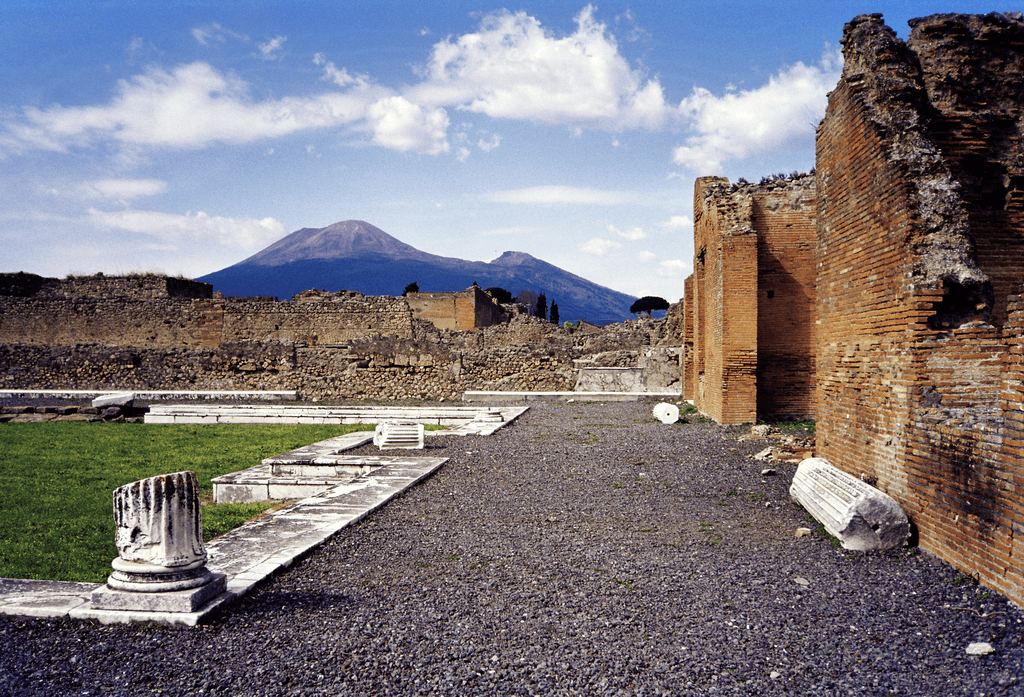
Initially, many residents chose to stay, believing the phenomenon to be transient. As the intensity escalated, however, the city descended into chaos. The day turned as dark as night, with volcanic ash blanketing the city and turning streets into mazes. Houses collapsed under the weight of pumice, and toxic fumes filled the air.
In the aftermath of the eruption, a pyroclastic surge – a high-speed avalanche of hot ash, rock, and gas – swept over Pompeii, burying the city and its remaining inhabitants under a thick layer of volcanic material. This final surge preserved Pompeii in a deathly stillness, with life as it was at the moment of disaster captured in extraordinary detail.
The eruption of Mount Vesuvius marked a tragic end to Pompeii’s bustling life. The city that had once teemed with life was now a tomb, its inhabitants and their vibrant culture buried beneath a layer of ash and pumice. Yet, while the eruption brought an end to Pompeii, it also unwittingly ensured its preservation, capturing a moment in time for future generations to study and marvel at.
Survivors and Stories of Escape
When Mount Vesuvius erupted on August 24, 79 AD, it caught the residents of Pompeii off guard. Yet, not all perished in the catastrophe. Some managed to escape, their survival stories providing invaluable insights into the disaster’s timeline and intensity.
There are numerous accounts of people fleeing the city amidst the chaos. Most likely, the initial phase of the eruption, characterized by the showering of pumice and ash, allowed a window of escape for those who acted promptly. Those who delayed, whether due to disbelief or an attempt to protect their property, faced a dire fate as the situation progressively worsened.
A notable survivor was Pliny the Younger, a Roman author and lawyer, who witnessed the eruption from Misenum, about 13 miles across the bay from Pompeii. His detailed letters to the historian Tacitus provide a critical firsthand account of the event. He described the panic and confusion, the darkness that turned day into night, and the desperation of the people. He also detailed the harrowing escape by ship of his uncle, Pliny the Elder, a naval fleet commander, who perished in the disaster attempting a rescue mission.
The exact number of survivors remains uncertain due to the lack of historical records. However, archaeological evidence suggests that many people may have successfully evacuated Pompeii before the lethal pyroclastic surges. A relatively small number of bodies compared to the estimated population and the abundance of looted houses suggest a significant portion of the population might have fled in time.
In the aftermath, the survivors faced immense challenges. They were forced to abandon their homes and lives, seeking refuge in nearby settlements. They mourned lost loved ones, and their stories passed down through generations, echoing the profound human cost of the disaster.
The stories of escape and survival serve as potent reminders of the resilience of the human spirit amidst nature’s terrifying force. They bring to life the reality of the disaster beyond the silent remains of Pompeii, adding an essential human dimension to the archaeological and geological record.
Archaeological Excavations and Discoveries
The rediscovery of Pompeii didn’t occur until the late 16th century when architect Domenico Fontana stumbled upon the ruins during the digging of an underground channel. However, the significance of the discovery wasn’t realized, and Pompeii remained largely forgotten until the mid-18th century.
The systematic exploration of Pompeii began under King Charles III of Bourbon in 1748, with the intent of unearthing Roman antiquities for his museum. These early excavations focused more on recovering valuable artifacts than scientific understanding. As such, archaeology during this period was relatively haphazard, lacking a structured approach and damaging some aspects of the site.
In the 19th century, Giuseppe Fiorelli took charge and brought significant changes to Pompeii’s excavation methods. Fiorelli introduced systematic, stratigraphic excavation, dividing the city into ‘regiones’ and ‘insulae’ for better recording and management. His most famous contribution was the use of plaster casts to capture the final moments of the victims, providing a hauntingly vivid snapshot of the disaster.
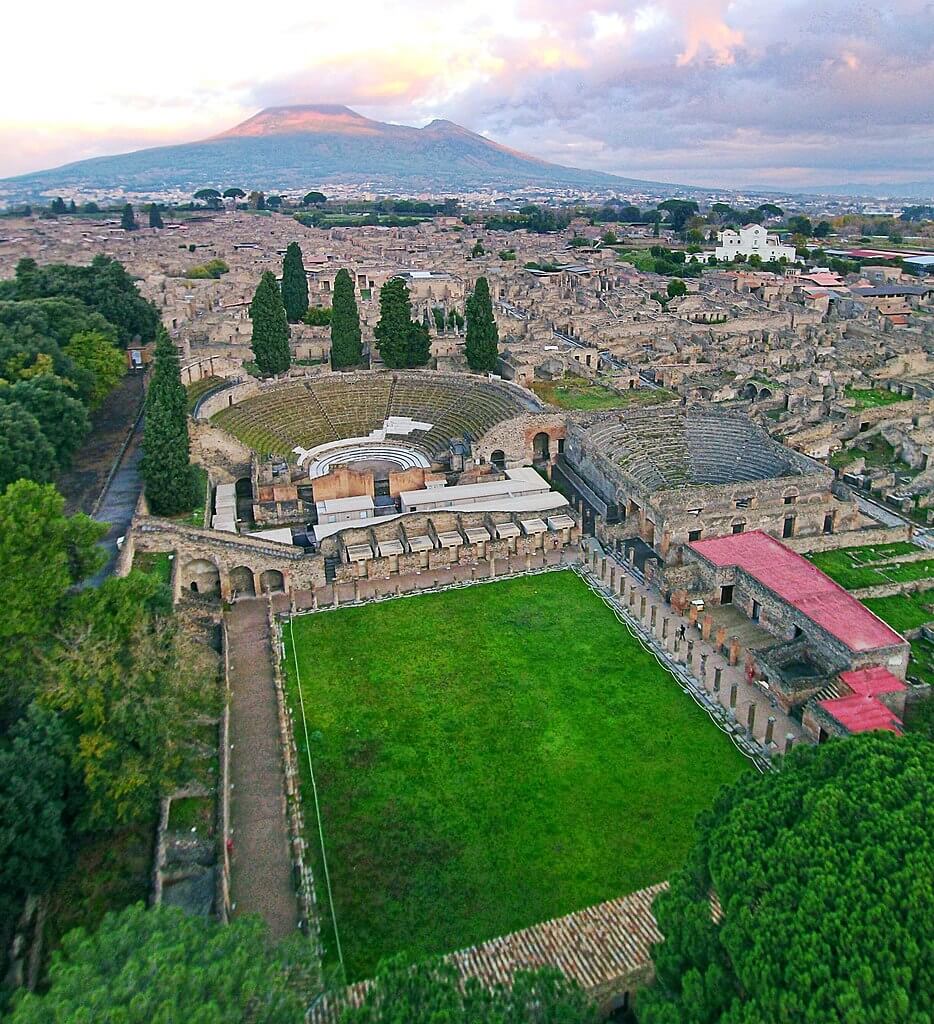
Excavations in the 20th and 21st centuries have adopted more modern and conservation-conscious techniques. Archaeologists now use non-invasive methods like ground-penetrating radar and drone photography to investigate unexcavated areas and monitor the site’s conservation status. Advances in forensic archaeology, such as DNA analysis and CT scanning, have provided deeper insights into Pompeii’s inhabitants and their lives.
These excavations have unearthed a wealth of artifacts, including frescoes, mosaics, statues, and everyday household items, providing a unique time capsule of Roman life. Findings have revealed details about Roman architecture, social structure, diet, and culture, making Pompeii an invaluable source of historical and archaeological information.
Today, despite centuries of work, a significant portion of the city remains unexcavated. Each new excavation season at Pompeii promises the potential for fresh discoveries, offering continued insights into this once-thriving Roman city and its dramatic end.
Remains of Pompeii – Buildings and Graffiti
Pompeii offers a remarkable preservation of ancient Roman urban life. Its buried buildings and graffiti provide extraordinary insight into its inhabitants’ everyday lives, societal structure, and cultural preferences.
Among the most notable structures are the residential buildings, ranging from simple, modest houses to luxurious villas. The domus, or homes of the wealthy, were typically elaborate, featuring atriums, private baths, ornate frescoes, and mosaic floors. The House of the Vettii, owned by prosperous freedmen, is one such example, filled with richly decorated rooms and courtyards. In contrast, the lower classes often resided in insulae, multi-story apartment buildings with basic amenities.
Public buildings in Pompeii were equally impressive. The Forum, the city’s main public space, was surrounded by important civic and religious buildings. Temples dedicated to various deities, such as the Temple of Jupiter and the Temple of Isis, highlight the religious diversity of the city. The city also housed a large amphitheater, a testament to the Romans’ love for public spectacles like gladiatorial games.
Pompeii’s streets and walls were adorned with graffiti, offering fascinating glimpses into the citizens’ minds. The graffiti ranged from political campaign slogans and commercial advertisements to personal messages and love declarations. They serve as a direct voice from the past, reflecting the thoughts, humor, and concerns of ordinary people.
One of Pompeii’s most unique aspects is its brothels, particularly the Lupanar, the largest of them. The explicit frescoes on its walls served as a “menu” for clients, providing a candid view of Roman sexuality.

These architectural remnants and graffiti constitute a tangible connection to the past. They present a vivid picture of ancient Roman life, from grand public spectacles to intimate private moments, from the affluent lives of the wealthy to the simpler existence of ordinary citizens. They encapsulate a society rich in its diversity, complexity, and humanity, frozen in time by a catastrophic event.
Pompeii Today – An Open-Air Museum
Today, Pompeii stands as one of the world’s most famous archaeological sites, attracting millions of visitors each year. The city, once buried under a thick layer of ash and pumice, has been painstakingly unearthed and now serves as an open-air museum, allowing visitors to step back in time and experience life as it was nearly two millennia ago.
Visitors to Pompeii can walk its ancient streets, visit homes, temples, shops, and public buildings, and even view the haunting plaster casts of the victims. Guided tours provide an immersive experience, detailing the city’s history, the daily lives of its inhabitants, and the catastrophic event that led to its preservation. Interactive experiences, such as virtual reality tours, enhance this journey through time, offering a 360-degree view of Pompeii as it was at the moment of its demise.
Online resources, such as Pompeii Online and Pompeii Sites, further extend the reach of this archaeological treasure to a global audience. This platform offers virtual tours, detailed information about Pompeii’s history, architecture, and art, and updates on ongoing excavations and discoveries. These online platforms help make Pompeii accessible to those who can’t visit in person and serve as an educational resource for students and history enthusiasts alike.
Moreover, Pompeii continues to contribute to ongoing scientific research. Archaeologists, historians, and scientists from around the world engage in the study and conservation of the site. New discoveries continue to emerge, further enriching our understanding of this ancient city and its people. Despite the passage of time and the devastating event that marked its end, Pompeii remains a vibrant testament to the past, continuing to educate, fascinate, and inspire.
Pompeii in Popular Culture – Focus on the 2014 Film
The enduring intrigue surrounding Pompeii has made it a popular subject in various forms of media, including cinema. Notably, the 2014 film “Pompeii”, directed by Paul W.S. Anderson, attempted to capture the final days of the city, with Kit Harington of “Game of Thrones” fame in the lead role.
In the film, Harington plays Milo, a gladiator who falls in love with Cassia, a wealthy merchant’s daughter, portrayed by Emily Browning. The plot intertwines their forbidden love story with the impending disaster, culminating in the catastrophic eruption of Mount Vesuvius.
In terms of historical accuracy, the film presents a mixed bag. The depiction of Pompeii’s architecture, the gladiatorial games, and the class distinctions are generally well-researched and recreated with an eye for detail. The eruption sequence, while dramatized for cinematic impact, captures the horror and chaos that likely ensued.
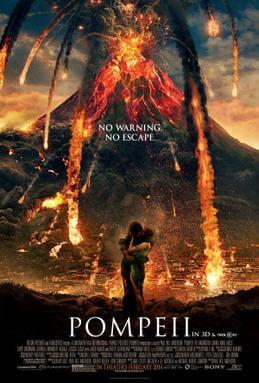
However, the film takes considerable liberties in its narrative. The central love story, for instance, is a work of fiction, and some characters are not historically grounded. The timing of the eruption, portrayed to occur at night for dramatic effect, contradicts historical accounts and scientific evidence suggesting it began at midday.
The film’s visualization of the pyroclastic surge is similarly sensationalized. While it undoubtedly captures the terrifying spectacle of such an event, the idea that people could outrun or survive this phenomenon, as portrayed in the film, is scientifically inaccurate. In reality, the pyroclastic surges would have traveled at extremely high speeds, with temperatures high enough to cause instantaneous death.
Despite these inaccuracies, the 2014 “Pompeii” film serves as an engaging cinematic interpretation of the city’s final days. While it should not be viewed as a completely accurate historical account, it offers a dramatic and visually stunning representation of one of history’s most infamous natural disasters, capturing the public’s fascination with the lost city of Pompeii.
Historical Challenge: Can You Conquer the Past?
Answer more than 18 questions correctly, and you will win a copy of History Chronicles Magazine Vol 1! Take our interactive history quiz now and put your knowledge to the test!

